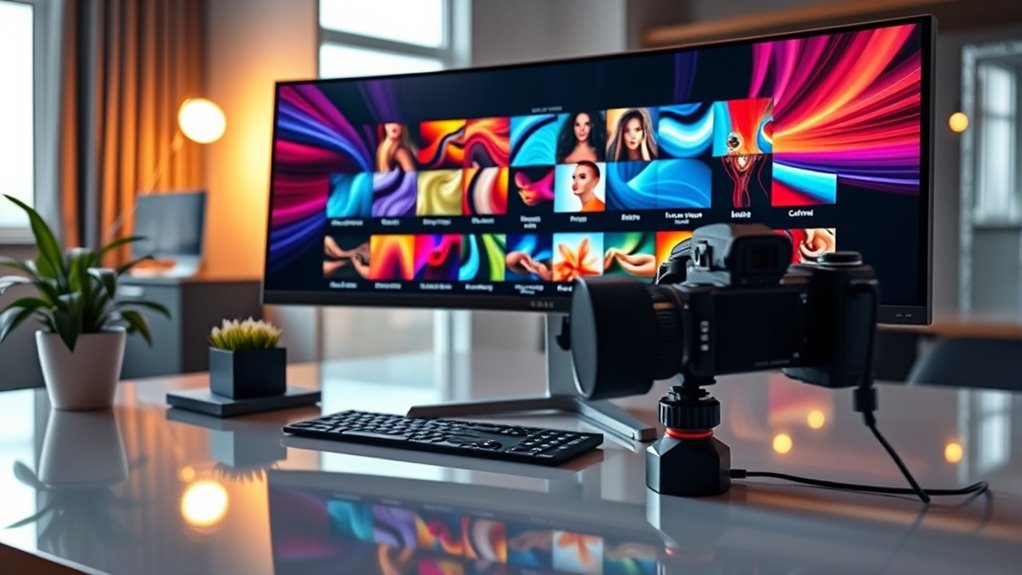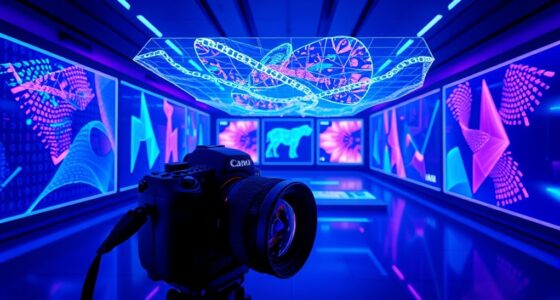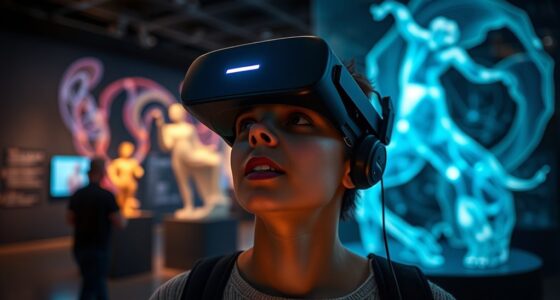AI art recommendation systems use advanced algorithms to personalize your experience by suggesting artwork aligned with your tastes and preferences. They learn from your interactions, like liking or sharing, to continuously refine suggestions and keep content relevant. These systems analyze your browsing habits and explore new styles to expand your horizons while maintaining diversity. As your digital gallery evolves, you’ll discover fresh artworks effortlessly. Keep exploring to see how these intelligent systems enhance your art journey.
Key Takeaways
- Utilize personalization algorithms to tailor artwork suggestions based on individual user preferences and interactions.
- Implement continuous feedback loops to refine recommendations and adapt to evolving user tastes.
- Analyze browsing and engagement data to identify patterns and predict artworks likely to appeal to users.
- Foster interactive experiences through commenting, following, and community challenges to enhance recommendation accuracy.
- Balance personalized content with diversity algorithms to introduce new art styles and artists, promoting discovery.

AI art recommendation systems are transforming the way you discover and engage with digital artwork. These systems leverage advanced personalization algorithms to tailor content specifically to your tastes and preferences, making your browsing experience more intuitive and enjoyable. Instead of sifting through countless pieces manually, you’re presented with artwork that aligns with your unique interests, keeping you engaged and inspired. As you interact with the platform—liking, sharing, or saving pieces—the algorithms learn from your actions, refining their suggestions to better match your evolving tastes. This continuous feedback loop enhances user engagement, guaranteeing that the content remains relevant and engaging.
AI art recommendations personalize your browsing, keeping your experience engaging, intuitive, and tailored to your evolving tastes.
Personalization algorithms play a vital role in delivering a more meaningful connection between you and the art you explore. They analyze various data points, such as the types of artwork you’ve viewed, your browsing history, and even your interactions with other users. By understanding these patterns, the system predicts what you’re most likely to enjoy next, reducing the frustration of endless scrolling and helping you discover new artists or styles you might not have encountered otherwise. This targeted approach not only saves you time but also deepens your appreciation for digital art by consistently offering pieces that resonate with your personal aesthetic.
Moreover, these recommendation systems foster a more interactive experience. As you engage more with the platform—commenting on pieces, following artists, or participating in community challenges—the system gathers even richer data. Consequently, your feed becomes more finely tuned to your preferences, creating a personalized digital gallery that evolves alongside your interests. This ongoing adaptation keeps you motivated to explore and interact, turning casual browsing into a more immersive experience. The heightened user engagement benefits both you and the platform, as more active participation often leads to better content curation and community growth.
In addition, AI-powered recommendation systems often incorporate diversity algorithms to expose you to a broader spectrum of art. While personalization ensures you see artworks aligned with your tastes, diversity algorithms introduce fresh styles or lesser-known artists that might expand your horizons. This balance between personalization and discovery keeps the experience dynamic and prevents stagnation. Ultimately, these systems are designed to make your journey through digital art more personalized, engaging, and enriching—transforming the way you connect with creative expressions in the digital space.
Frequently Asked Questions
How Do AI Recommendation Systems Handle User Privacy Concerns?
You can trust that AI recommendation systems prioritize your privacy by implementing robust privacy safeguards and data anonymization techniques. They limit the collection of personal data and ensure that your information remains confidential. By anonymizing data, they prevent identification of individuals, reducing privacy risks. These measures help protect your sensitive information while still providing personalized art suggestions, so you enjoy a customized experience without compromising your privacy.
Can AI Art Suggestions Adapt to Evolving User Tastes Over Time?
Yes, AI art suggestion systems can adapt to your evolving tastes over time. They improve personalization accuracy by continuously integrating your feedback, such as likes or dislikes, into their algorithms. As you provide more input, the system refines its recommendations, making them more aligned with your current preferences. This dynamic process guarantees that your art suggestions stay relevant and engaging, capturing your changing artistic interests effectively.
What Are the Limitations of Current AI Algorithms in Art Recommendations?
You should know that current AI algorithms face limitations like algorithm bias, which can skew recommendations toward certain styles or artists, reducing diversity. They struggle with capturing true creative diversity and context, often missing nuanced human preferences. As a result, your suggestions might become repetitive or less personalized over time. These challenges highlight the need for ongoing improvements to better reflect evolving tastes and foster more varied, authentic art recommendations.
How Do Cultural Differences Influence AI Art Recommendation Accuracy?
Cultural differences markedly impact AI art recommendation accuracy by shaping users’ artistic preferences. For example, a platform in Japan may recommend traditional ukiyo-e prints, but the AI might overlook these preferences if it’s trained mainly on Western art, missing cultural context and artistic diversity. This results in less relevant suggestions, highlighting the need for diverse training data that reflects global artistic expressions to improve recommendation relevance worldwide.
Are There Biases in AI Algorithms That Affect Art Suggestions?
Yes, algorithm bias can affect your art suggestions, often reflecting cultural influence embedded in the data. These biases may lead the system to favor certain styles or artists, overlooking diverse perspectives. As a result, your recommendations might lack cultural variety or reinforce stereotypes. Being aware of this helps you understand that biases are present and encourages you to seek more inclusive art options beyond algorithmic limitations.
Conclusion
You now see how AI art recommendation systems can be your guiding compass through a vast ocean of creativity. They connect your unique tastes to stunning works, turning every browsing session into a personalized journey. Like a trusted friend, these systems understand your preferences and introduce you to hidden gems. Embrace this technology, and let it be the painter that colors your world with inspiration and wonder. Your next masterpiece might just be a click away.









